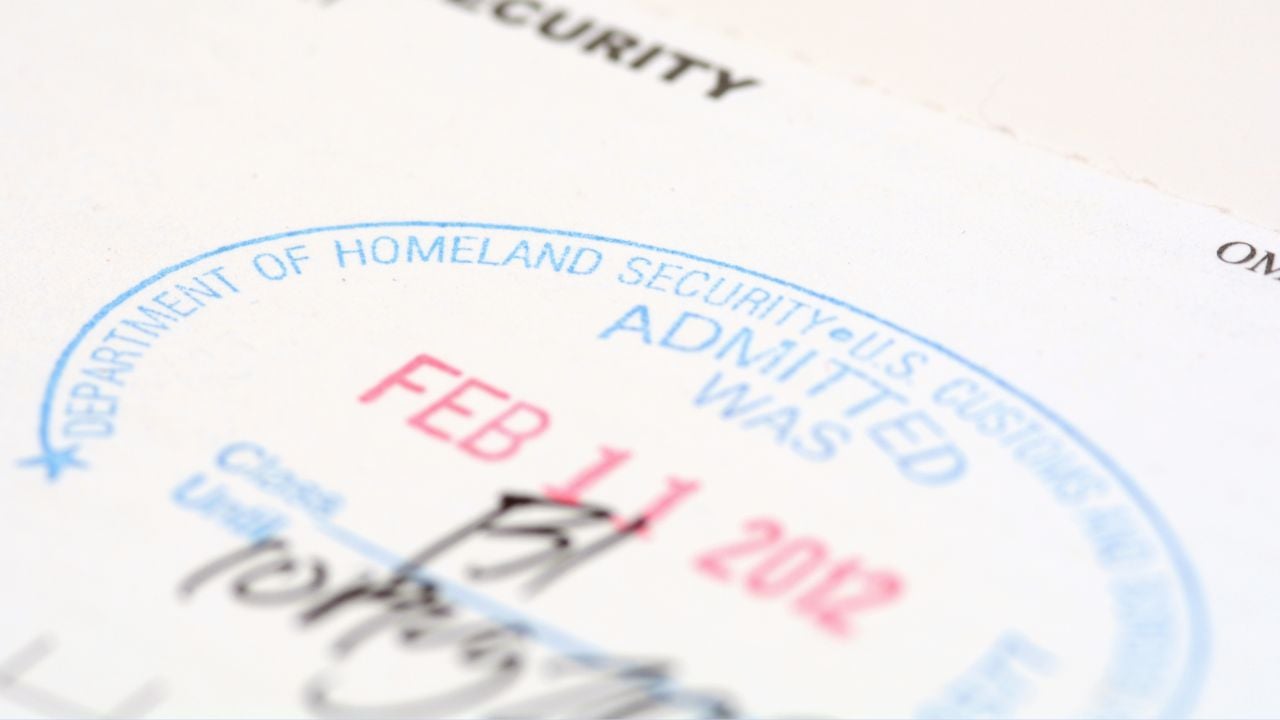Share this
How to Reinstate Your F1 Status: Essential Steps to Follow
by Bole Huang on May 03, 2024
.jpg?width=2240&height=1260&name=D1CU%20Blog%20Banner%20(8).jpg)
Maintaining F-1 status is crucial for international students in the United States. However, unintentional violations can lead to the loss of this status. In such cases, it is vital to act quickly, as there is no grace period for students who fall out of status. To resume F-1 status, students have two options: (1) reinstatement and (2) traveling abroad and reentering the United States. The reinstatement process can be complex, and it is advisable to consult with your International Student Services (ISS) adviser at your university or an immigration expert to enhance the likelihood of approval.
1. Common Reasons for SEVIS Termination
Maintaining F-1 status is crucial for international students studying in the United States. Failing to adhere to the regulations set by the U.S. Citizenship and Immigration Services (USCIS) can lead to a violation of your F-1 status, resulting in serious consequences such as SEVIS termination, loss of benefits, and potential deportation.
Some common reasons for F-1 status violations include:
❗️Academic Violations
- Failing to enroll in classes or maintain a full course of study
- Unauthorized withdrawal from classes or dropping below the required course load without prior approval
- Expulsion or suspension from the university
- Enrolling in too many online or distance learning courses
- Failing to complete your degree program within the expected timeframe
❗️Employment Violations
- Engaging in unauthorized employment, either on or off-campus
- Working without advanced authorization from the Office of International Affairs (OIA) or USCIS
- Failing to report Optional Practical Training (OPT) employment
- Exceeding the allowed number of unemployment days while on OPT
❗️Administrative Violations
- Failing to report your arrival to the university's international student office
- Not updating your local residential address as required
- Failing to extend your I-20 before the program end date
- Not maintaining a valid passport or allowing your I-20 to expire
- Violating university policies that result in the loss of eligibility to enroll
If you find yourself in a situation where you may have violated your F-1 status, it is essential to seek guidance from your university's international student services office and consider the options available, such as applying for reinstatement or departing the U.S. and seeking a new admission.
2. Eligibility Criteria for Reinstatement
International students must meet specific criteria to be eligible for F1 reinstatement through USCIS. First and foremost, the student must not have been out of status for five months when filing the reinstatement request unless exceptional circumstances prevented them from filing within that time frame.
Additionally, the student must:
- Have no record of repeated or intentional violations of USCIS regulations
- Be currently pursuing or intending to pursue a full course of study in the immediate future
- Not have engaged in unauthorized employment
- Not be deportable on any circumstances other than failing to maintain F1 status
Students who meet the specified circumstances are eligible to apply for F1 Reinstatement beyond the five-month limit:
- Serious injury or illness
- Closure of the educational institution
- A natural disaster
- Inadvertence, oversight, or neglect on the part of the Designated School Official (DSO)

3. Preferred Option: Applying for F1 Reinstatement with USCIS
If you have violated your F-1 status and wish to regain it without leaving the United States, you can apply for reinstatement through the U.S. Citizenship and Immigration Services (USCIS). This process involves submitting a reinstatement application, which currently costs $470 and typically takes around five months to be processed. It's important to note that if your reinstatement application is denied, you will be required to depart the U.S. immediately.
3.1 - F1 Reinstatement Application Steps
Step 1: Obtain acceptance and a new I-20 form from a SEVP-certified university.
Fill out the form to get free assistance
(get new I-20 as soon as in one day)
Step 2: Submit the following materials to USCIS
- Completed Form I-539 and Form I-539A for each co-applicant
- Filing fee of $470.00 and a biometrics service fee of $85.00 for every applicant and co-applicant
- Detailed, typed letter explaining the violation and how it resulted from circumstances beyond your control
- Evidence of financial support
- Academic transcript
- New Reinstatement I-20 issued by your school's international student office
- Copy of SEVIS I-901 fee payment receipt
- Immigration documents, such as previous I-20s, I-94, and passport copy
3.2 - Important Considerations
Employment: Stop CPT/OPT working immediately once you've violated your student status.
Denial: If denied, prepare to leave the U.S., as there is no appeal process.
Consequences: Denial may limit future nonimmigrant visa applications and trigger unlawful presence.
*Please review the notice for the date of departure. Otherwise, the leaving date will be assumed to be the same day.
Timing: File within 5 months of falling out of status, unless exceptional circumstances apply.
3.3 - Reinstatement Application Processing and Outcomes
✅ Application approved
You resume F-1 status and become eligible for all F-1 student benefits.
❌ Application denied
You must depart the U.S. immediately to avoid accruing unlawful presence.
While your reinstatement application is pending, you cannot work on-campus or outside. If your application is approved, your current SEVIS record (I-20) is reinstated, and you immediately become eligible for all F-1 benefits again. However, if your application is denied, it is recommended that you work with a qualified immigration attorney to explore your options, as you will be expected to leave the country promptly to avoid serious consequences.
*If USCIS approves your reinstatement, you will resume active F-1 status. However, you must leave the U.S. immediately if your application is denied. Remaining in the country after denial for over 180 days will result in a three-year bar from returning, while staying for one year or more will lead to a ten-year bar. To avoid these consequences, it's essential to work closely with your ISS adviser and consider seeking the advice of an immigration attorney to improve your chances of a successful reinstatement.
🌟- How do I write a reinstatement letter for f1?
REINSTATEMENT LETTER SAMPLE
[Your Full Name]
[Your Address]
[City, State, ZIP Code]
[Email Address]
[Phone Number]
[Date]
United States Citizenship and Immigration Services (USCIS)
P.O. Box 660166
Dallas, TX 75266
RE: F-1 Student Reinstatement
To Whom It May Concern:
In the first paragraph, explain when you entered the U.S., what the status was, and why. Describe the activities you have been engaged in since arriving in the U.S.
Example: "I entered the United States on [Date] as an F-1 student to pursue a degree in [Your Major] at [Your School]. Since then, I have been diligently attending my classes and maintaining a strong academic record. I have also been actively participating in various campus activities and organizations to enhance my educational experience."
In the second paragraph, explain why you are out of status and when the violation of status occurred.
Example: "I am currently out of status due to [explain the reason, e.g., financial difficulties, medical issues, etc.]. The violation of my status occurred on [specific date or period]."
Next, explain how you feel your violation of status was either due to circumstances beyond your control or related to a reduction in your course load that would have been within the International Student Advisor’s power to authorize. Also, stress that failure to receive reinstatement would result in extreme hardship.
Example: "I believe my violation of status was due to circumstances beyond my control. [Provide detailed explanation]. This situation has caused significant distress, and failure to receive reinstatement would result in extreme hardship as it would jeopardize my academic and professional future."
Next, explain why you feel you are eligible for reinstatement. Highlight the following points:
- You have not been out of status for more than 5 months, or you can demonstrate exceptional circumstances if you have been out of status longer.
- You are currently or will be a full-time student.
- You have not worked illegally.
- You have not done anything else to violate your status.
- You do not have a record of repeated or willful violations of your F-1 status.
Example: "I am eligible for reinstatement because I have not been out of status for more than five months. I am committed to continuing my studies as a full-time student. I have not engaged in any unauthorized employment and have adhered to all other F-1 visa regulations. Additionally, I do not have a record of repeated or willful violations of my F-1 status."
Finally, reaffirm your non-immigrant intent by stating your plans following the completion of your degree. This should include returning to your home country.
Example: "Upon completing my degree, I intend to return to my home country of [Your Home Country] to apply my education and skills in [specific field or job]. I am dedicated to contributing to my community and believe that my education in the U.S. will allow me to achieve these goals."
Sincerely,
[Your Signature]
[Your Printed Name]
4. Backup Plan: Travel and Reentry
For international students who have violated their F-1 status, traveling outside the United States and re-entering with a new I-20 can be an alternative to regaining lawful status. This process involves obtaining a new "Initial Attendance" I-20 from your current or new school's international student office, departing the U.S., applying for a new F-1 visa if necessary, and re-entering the country.
4.1 - Steps for Travel and Reentry
- Obtain acceptance from a SEVP-certified university.
- Obtain a new "Initial Attendance" I-20 from your school's international student office.
- Depart the United States.
- Apply for a new F-1 visa if your current visa has expired or will expire before your re-entry.
- Re-enter the U.S. using your new I-20 and valid F-1 visa.
4.2 Considerations for Travel and Reentry
Visa Status: If your F-1 visa has expired, you must apply for a new one before returning to the U.S.
Practical Training Eligibility: Students who regain status through travel and reentry are considered "initial status" students, which may affect their eligibility for Curricular Practical Training (CPT).
SEVIS Record: Travel and reentry will lead to the production of a new SEVIS ID and record.
Comparison: While faster than reinstatement, travel and reentry still may have a higher deny chance than reinstatement.
-
If you want to use Day 1 CPT and enter the US as an initial I-20 student, you may not be authorized for CPT to work at most universities on the first day of your program. However, we have compiled a list of universities that allow you to work on the first day of your I-20. Here is the list that could benefit you:
- Westcliff University
- New England College (NEC)
- Trine University
- Monroe Colleg
- Harrisburg University
- Saint Peter’s University
- McDaniel College
5. F1 reinstatement costs
Reinstatement Costs
- USCIS Form I-539 filing fee: $470
- Biometrics service fee: $85 for every applicant and co-applicant
- SEVIS Fee payment: $350
Travel and Reentry Expenses
- SEVIS fee: $350
- Travel costs (airfare, transportation, accommodations)
- Visa application fees (if applicable)
6. How long does it take for USCIS to process f1 reinstatement?
F1 Reinstatement Timing
To verify the current processing times for an F-1 reinstatement application, you can directly check the USCIS website. Here are the steps to follow:
- Visit the USCIS Website: Go to USCIS.gov.
- Navigate to Tools: Under the "Tools" section, you will find various self-help tools. One of these tools is "Check Case Processing Times."
- Select the Form: Choose the appropriate form (typically Form I-539, Application to Extend/Change Nonimmigrant Status) and the appropriate service center handling your case.
- View Processing Times: The website will display the current estimated processing time for the form and service center you selected.
USCIS generally processes an F-1 reinstatement application in several months, with typical durations of around five months. However, processing times can vary based on the specifics of each case and the current workload at USCIS.
For the most accurate and up-to-date information, it is advisable to check the USCIS website directly under their processing times section or any recent announcements related to F-1 reinstatement applications. This will help ensure you have the latest details regarding processing times and any changes in procedures.
7. FAQs
1. Can I still travel within the US after my SEVIS is terminated?Yes, you can still travel within the United States after your SEVIS is terminated.
2. What does the 5-month rule mean for an F1 visa?When a student transfers their SEVIS record from their previous school to a new one, the new school's program start date must be within 150 days of the previous school's program completion date or the student’s OPT end date.
3. What options are left for me if F1 reinstatement is denied?- Depart the United States and Re-enter with a New I-20 (D1CU can help!)
- File a Motion to Reopen or Reconsider
Yes, you can renew your Form I-20 even if your F-1 visa has expired. However, if you plan to leave and re-enter the U.S., you must apply for a new F-1 visa with your updated I-20.
5. Can I use my b1 visa to reenter the US after I get SEVIS terminated?
If your SEVIS record has been terminated, it may affect your ability to use a B1 visa for entry into the United States.

Share this
- Day 1 CPT (32)
- H1B (24)
- Day 1 CPT Universities (18)
- H1B Lottery (11)
- CPT (6)
- Green card (5)
- University Application (4)
- F1 (3)
- F1 Status (3)
- International Students (3)
- USCIS (3)
- Westcliff University (3)
- Concordia University Texas (2)
- F1 Reinstatement (2)
- H1B Layoff (2)
- H1B Status (2)
- OPT (2)
- STEM OPT (2)
- change of status (2)
- Bay Atlantic University (1)
- Curry College (1)
- English Proficiency (1)
- Goldey-Beacom College (1)
- Green Card Application (1)
- H4 EAD (1)
- H4 Visa (1)
- Humphreys University (1)
- Immigration (1)
- International Student Travel (1)
- Jobs (1)
- L1 (1)
- Layoff (1)
- McDaniel University (1)
- O1 (1)
- Saint Peter's University (1)
- Salem University (1)
- Scholarships (1)
- Sofia University (1)
- Tax (1)
- December 2025 (1)
- November 2025 (2)
- October 2025 (1)
- September 2025 (3)
- August 2025 (2)
- June 2025 (1)
- May 2025 (2)
- March 2025 (2)
- November 2024 (2)
- October 2024 (4)
- September 2024 (3)
- August 2024 (3)
- July 2024 (2)
- June 2024 (7)
- May 2024 (3)
- April 2024 (4)
- March 2024 (3)
- February 2024 (5)
- January 2024 (1)
- October 2023 (3)
- September 2023 (6)
- August 2023 (10)
- July 2023 (3)
- June 2023 (4)
- May 2023 (1)
- April 2023 (1)
- February 2023 (1)
- November 2022 (1)
- October 2022 (3)
- September 2022 (1)
- August 2022 (1)

Full Day 1 CPT Universities List
Click here to view 30+ Day 1 CPT universities in different states
Scholarships & Payment Plan
Click here to explore extensive scholarships and financial aids
Get Free Assistance Now
We can help you with admission, fee waiver, and scholarships
Featured Articles
Studying and Working in the US

What If a Second Master’s Degree Isn’t Allowed? Why a Day 1 CPT DBA Could Be Your Best Path Forward
-Nov-22-2025-12-02-59-3078-AM.jpg)
Which Day 1 CPT Programs Offer a Fixed Summer Break? You Won’t Believe How Rare the Answer Is…

Why Curry College is a Top Choice of Day 1 CPT in Boston

Concordia University Texas Launches New MCS Program - A Top STEM Day 1 CPT Option





.png?width=204&height=68&name=Verified%20(2).png)


.png?width=250&height=83&name=Logo%20-%20Rectangle%20(2).png)
.png?width=250&height=83&name=Logo%20-%20Rectangle%20(1).png)
